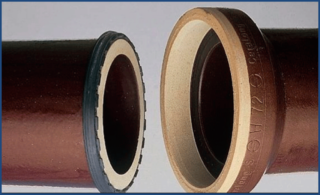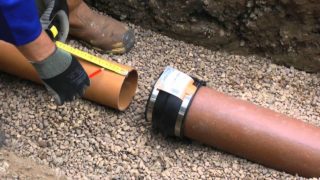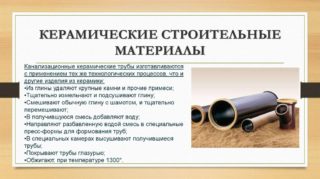Ceramic sewer pipes are the oldest underground sewage systems. They were first used in Ancient Rome and India. Nowadays, due to their properties, they have not lost their popularity and, along with analogues made of cast iron and polymers, are widely used in various fields.
Specifications
- length: 1000 mm, 1250 mm, 1500 mm, 2000 mm, 2500 mm;
- inner diameter (nominal bore - DN (DN)): from 100 to 1200-1400 mm;
- wall thickness: from 19 to 36-50 mm;
- weight of 1 pipeline - from 30 to 400-500 kg;
- water absorption - products of the highest and first grade absorb moisture no more than 8-9% of their weight;
- strength and waterproofness - ceramic pipes are completely tight and can withstand internal hydraulic pressure up to 1.5 kgf / cm2;
- smoothness and coverage of pipe surfaces: coated with chemically resistant glaze;
- straightness deviation: no more than 9-11 mm per 1 running meter;
- inner diameter of the connecting part (socket) / its depth: from 234 to 1530 mm at a depth of 60-80 mm.
The regulatory document, in addition to the characteristics of ceramic pipelines, regulates the methods of their testing and acceptance.
Types of ceramic pipes

Depending on the type of connection, ceramic pipes are divided into 2 types:
- Bell-shaped - products have a cylindrical or bell-shaped expansion (bell) at one end;
- Socketless - both ends are smooth and of the same diameter. They are connected using special couplings with O-rings inside.
Bell-shaped products, due to the reliability and simplicity of their connection, have become more widespread than socketless ones.
Scope of application
Ceramic sewer pipes are used for the following purposes:
- drainage system installation;
- laying of external sewerage networks;
- installation of urban sewers and small tunnels;
- the device of special sewerage in laboratories and in chemical industries.
In addition to transporting and collecting waste water, ceramic pipes are also used as chimneys in wood-burning stoves and solid fuel boilers.
Due to its large diameter, weight and fragility, a ceramic pipe is not used in domestic sewer networks.
Installation features

Laying of an external yard sewage system using ceramic pipes with an inner diameter of 100 mm is as follows:
- Digging a trench to a depth of 80-100 cm with a mandatory slope towards the well equal to 2% (2cm / m).
- Filling a mixture of sand and gravel with a thickness of 15-20 cm to the bottom of the ditch with the obligatory careful compaction.
- Laying pipes with docking and sealing the junction with tarred hemp twine - strands of sealing material are wrapped 3-4 times around the junction, after which a "lock" of bitumen mastic or cement-sand mortar is poured over their turns.
- Backfilling of the pipeline with 4-5 layers of fine sand 10-15 cm thick with careful compaction of each.
- Laying on top of compacted layers of fertile soil.
The installation of pipes begins from a viewing sewer well, laying them in such a way that the sockets are directed against the direction of flow of wastewater.
Despite the apparent simplicity, such a sewage laying technology is more laborious and complex - it is, first of all, the large weight of the ceramic pipes and the need for careful sealing of their joints.
Advantages and disadvantages
Ceramic pipes in comparison with analogues made of cast iron and polyvinyl chloride (PVC) have both a number of advantages and disadvantages.
The benefits include:
- Durability - If properly used, ceramic piping can last 100 years or more.
- Environmental safety - the products do not contain artificial polymers and other components that decompose in the soil and can harm it.
- High strength - withstands loads far exceeding the weight of the soil and buildings.
- Resistant to high temperature and chemically aggressive effluents.
The main disadvantages are:
- Brittleness - although ceramics have high strength, they do not withstand strong point impacts, as a result of which they crack.
- Heavy weight - ceramic pipe is made of clay sintered under high temperature.
- High cost - prices for ceramic pipes for sewage are 8-10 times higher than for analogues made of cheaper and widespread PVC. This is due to their more complex production technology and the expensive raw materials used. For example, if a PVC pipe with a nominal bore of 110 mm and a length of 1000 mm will cost 150-200 rubles, then the price of a ceramic watercourse with a diameter of 100 mm and a length of 1200 mm is on average 1,500-2,000 rubles.
Another disadvantage of ceramic pipes is the need to use a special and rather expensive device for cutting - a chain pipe cutter.









